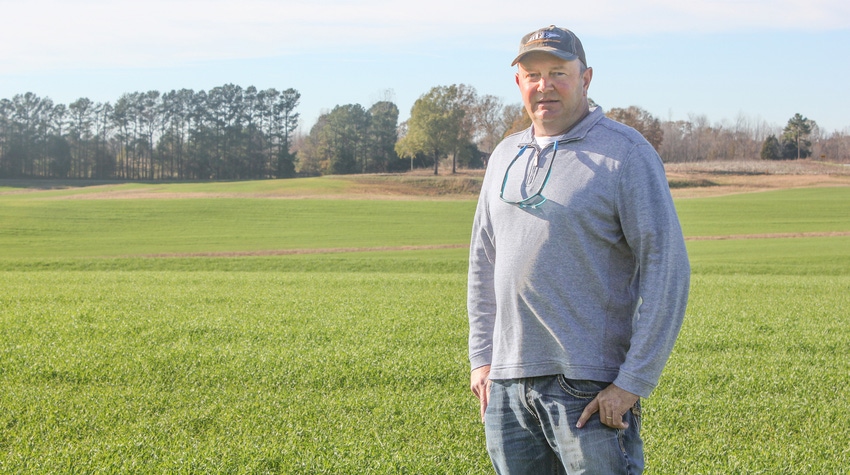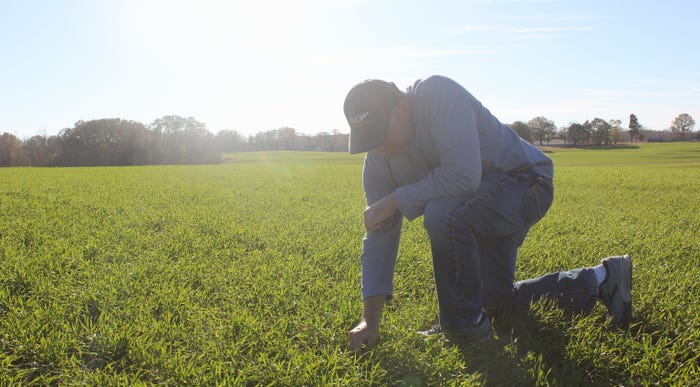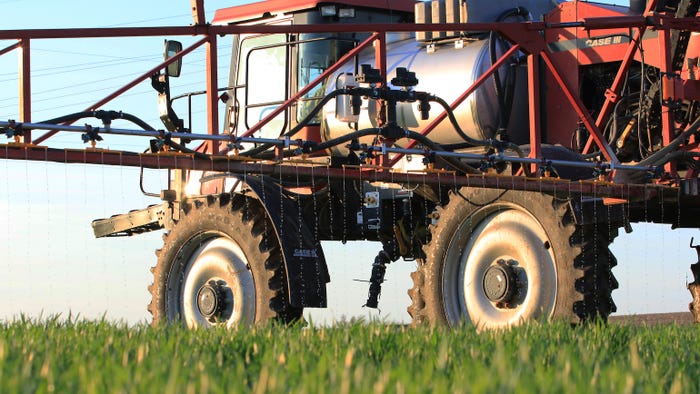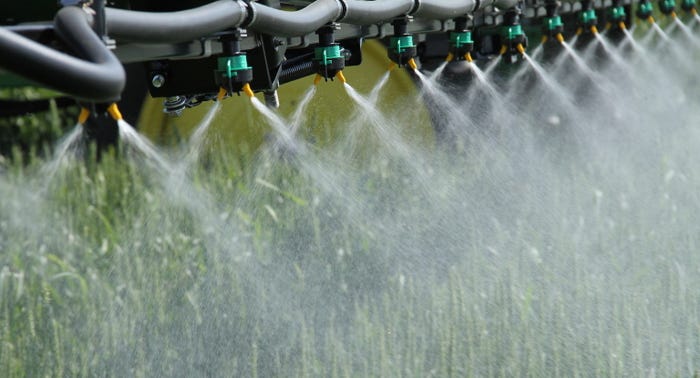
Wheat acres have been trending downward for the past eight years, but that may change in 2021. USDA is estimating a 1.7 million acre jump in wheat over the next year, with much of that increase coming from winter wheat.
What’s driving the renewed interest? Here, in the Midsouth, two things — price and weather. At planting, prices for June wheat were forecast to be over $6, while soybeans have generally trended upwards since summer. And many farmers saw reasonably good planting windows this fall.
“Good prices and a dry fall. That’s something we haven’t had together in at least three or four years,” said Hunter Hooper, a producer near Brownsville, Tenn. Hooper farms 5,000 acres of row crops. This October he planted 1,700 acres of winter wheat, which he’ll double crop to soybeans. Like many farmers, he’s optimistic about this first cash crop since the commodity price rally began in August.
“We’re probably $2 better on next year’s crop than we were going into the crop we’re coming out of now,” said Hooper. “Anytime you can do that makes it a lot more promising.
Wheat Farmer
While prices may have farmers returning to wheat after an extended hiatus, Hooper has been growing it as a cash crop for 15 years — even when prices and weather weren’t so good. Outside of last year’s extremely poor weather conditions, he’s bumped his yields to a five-year average of roughly 85 bu/a with intensive wheat management strategies. That’s well above his state’s five-year average (~67 bu/a) and the national five-year average (~52 bu/a).
“I still have room for improvement, and there’s a lot I’m still learning about the wheat crop itself,” Hooper said. “Around here wheat really hasn’t been treated right. It’s considered more of a glorified cover crop.”

Hooper believes that’s an inaccurate perception and sees many advantages to wheat, particularly on the rolling fields of “good Memphis hill dirt” that he farms. On the right ground, he says it can be a very beneficial rotation.
“I’ve got some ground that I cannot do dryland corn every year, especially when corn’s $3. So, I can do a full season soybean crop followed with wheat and then a wheat-bean crop, and I can get three crops in two years and do pretty good,” Hooper said. “Plus, a lot of these farms with rolling hill ground will make good wheat, and it’s cash flow in the middle of the year.”
Managing potential
Hooper no-tills most of his wheat. The exception being wheat planted behind 20-inch irrigated corn. He cites excessive residue as the main deterrent.
“In the corn, after the combine goes through, we usually run a narrow spacing disk or some kind of vertical tillage,” Hooper said. “Then we’ll hire an air flow, mix fertilizer with it and cover it up.”
He insists on using certified seed as opposed to bin run seed, and all of his seed is treated with insecticide and fungicide. Additionally, he puts out foliar fungicide applications in the spring and split-applies nitrogen making a pre-plant application followed by two additional applications in the late winter/early spring.
This year he is also trying out a new strategy — hiring an agronomist to help scout his wheat.
“I’ve never had a scout, this is my first year, but I think there’s an opportunity there to improve our crop management, and it is getting harder for me to scout the fields regularly.” In addition to farming, Hooper and his wife, Julie, own and operate Hooper Farms Equipment.
Getting boots on the ground is essential to any crop management, and one of the first steps of intensive wheat management according to Phil Needham, owner of Needham Ag Technologies, a crop management company near Calhoun, Ky. Needham has spent more than 30 years researching and consulting with farmers around on the world on intensive wheat management strategies.
“We always start out by determining the potential — going out in the fields getting stand counts, getting tiller counts, and determining how consistent and how healthy the wheat is,” said Needham. “Once we get that kind of information, we have some numbers to work with to make better decisions.”

Going forward
Needham is a native of Great Britain, where wheat acres typically average 150 bu/a. Since arriving in Kentucky 30 years ago his work has helped producers in the Bluegrass State double their wheat yields. This year with many farmers returning to wheat after a long break, or perhaps growing it for the first time as a cash crop, we asked Needham about winter and spring management strategies to boost yields.
“Nitrogen is the most cost-effective element you can apply to a wheat crop, so you want to apply as much nitrogen as you can to get the higher yields. However,” Needham cautions, “make sure you have short varieties that stand up to higher nitrogen programs. As long as you have the short varieties that stand good, we really push the nitrogen pretty hard in the spring to generate that higher potential.”
Needham advises a split-application of nitrogen and encourages producers to let the crop tell them when and how much to apply. He says getting nitrogen on at the right rate at the right time is the most important thing.

“For example, if the wheat is small when it begins to green up, we’ll generally go in there with around 60 pounds of actual nitrogen, and then come back with a balance around the jointing stage,” Needham said. “If the wheat is big and it has a lot of tillers, then the worst thing you can do is put a higher rate of nitrogen on it at green-up. We generally hold off longer on nitrogen if the wheat has a lot of growth and put more on later. Otherwise, it creates a lot of tillers and standability problems.”
The catch with applying higher rates of nitrogen, according to Needham, is that you have to chase that potential upward with foliar fungicides, otherwise diseases can be a challenge. He recommends two foliar fungicide applications – one at flag leaf emergence and one at flowering.
“So many growers want to do just one. You’re not going to maximize what you’re trying to do with just one fungicide application, especially if you push your nitrogen rates,” Needham advised. “The first fungicide protects the flag leaf and the upper parts of the plant, and the later fungicide is specifically targeting fusarium head blight. Fusarium can cause low test weight problems, dockage problems, so growers absolutely need that second fungicide at flowering.”

Weeds, insects and harvest
Needham says weeds and insects are often a weak link in wheat.
“We try to control all weeds in the fall, so we don’t have to spray them in the spring,” said Needham. “Generally, with most weeds, if you wait until spring to control them, you’ve lost yield because they compete with the crop.”
He also urges producers to be vigilant when scouting for insects, particularly aphids.
“Aphids are a vector of the barley yellow dwarf virus that’s responsible for 5 – 15-bushel yield losses in early planted crops,” said Needham. “It’s very important to deploy a foliar insecticide once they reach the threshold of 3-5 per square foot.”
The day we visit the Hooper farm Hunter is preparing to spray for aphids. For his weed management program, he has already applied a round of pre- and post-emergence herbicides. While he admits resistant ryegrass has become troublesome, he says having wheat in his rotation is helping suppress Palmer amaranth.
“Our wheat-bean fields are always some of the cleanest fields.”
He also has advice for farmers as they prepare to harvest this wheat crop.
“Start planning early,” he said. “You’ve got a small window to get it in and out. I’ll want to cut whatever I plant in 7-10 days. It’s tough to do, especially if you have cotton in the mix. You have to be ready to go when it’s time to harvest.”
About the Author(s)
You May Also Like






